The Cerutti Mastodon site is an archaeological site in San Diego so unexpected that even its discoverer, Richard Cerutti, a veteran paleontologist from the San Diego Natural History Museum and for whom the site is named, and lead field investigator Thomas Demere had a difficult time reconciling the evidence it yielded, which indicated a hominin presence in North America ~130,000 years ago,[1] more than a 100,000 years earlier than consensus estimates of ~15,000 years ago which coincides to the arrival of Homo sapiens via the Bering land bridge. Publication of the team’s research and data was delayed not by a matter of months, or even a year or two, but by an accumulation of the years as Cerutti and Demere wrestled with the implications of the find and brought in experts in related disciplines to provide further expertise and explore alternative possibilities that might explain the nature and location of the artifacts at the site, such as dispersal by flood, bone trampling and dispersal by other animals, or heavy machinery damage since the uppermost layer of the site was originally unearthed by Caltrans during a freeway project. None of these alternative possibilities could account for the unique arrangement of the artifacts and several of the artifacts themselves, including hammer stones and stone anvils, which could have only been transported to this particular fine grained site where they were used by hominin hands.

The hammer stones show evidence of percussion, the striking of rock against bone or other rock. Six stone fragments that were part of one of the larger hammer stones broke off during the percussion process and can be fitted back into the original stone. Several mastodon bones also show evidence of percussion, as indicated by impact notches and a unique pattern of spiral flaking and breakage that can only occur when the bone is fresh and the animal recently deceased (Holen, et al, 2017). The likely explanation is that the hominins used the hammer stones to break open the large, heavy bones of a mastodon to extract the nutritious marrow, and plausibly use the bones as tools as well (Holen, et al, 2017). Most of the bones and two pieces of a huge broken molar of the mastodon were located in two distinct areas, clustered around a stone anvil in each spot, as if to suggest these were the central work areas, however crude in character. Other striking features of the site were two femur heads lying side by side next to one of the stone anvils, broken off from the much larger femur bone, one face up and the other face down, and a partial mastodon tusk, which I roughly measured as 25 inches (63 centimeters) thrust vertically in the ground, suggesting purposeful intent, and excavated in this standing position. The other tusk was lying beside it, suggesting placement by hands as with the femur heads.
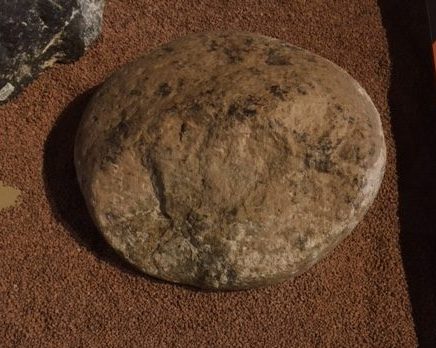
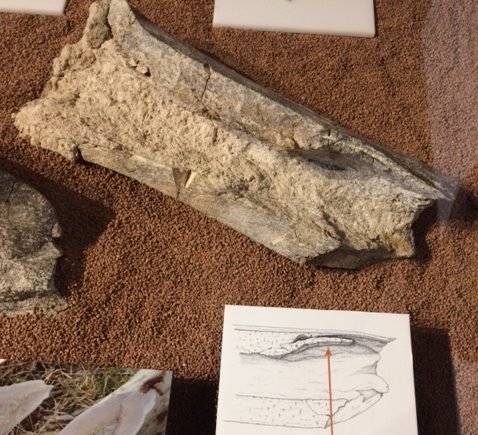
The difficult, seemingly impossible question for any researcher to grapple with—at least those who did not dismiss the research and claims outright, as several archaeologists have already done without so much as having visited the site or physically examined the evidence—is who could these hominins have possibly been, though Richard Cerutti and Demere have already deemed them to be a species of Homo, and how did they get there? That truly is a conundrum of epic proportions and illustrates why Richard Cerutti and Thomas Demere resisted publication for a time in order to cover every contingency. Our own species, Homo sapiens, was still in its infancy at this point in geologic history, exclusively concentrated in Africa, and would not even begin the slow trickle of migration into Europe, much less North America, until roughly 40,000 years ago. Some researchers have brought up the possibility of Neanderthals or Denisovans. Some have even raised the possibility of travel to North America by watercraft. Western North America is a long way from the domain of the Neanderthals, Europe and the Levant, and this alone stretches credibility. Denisovans? The earliest use of watercraft by hominins is contentious, and what evidence there is at this time indicates smaller island hopping voyages that might just as likely be accidental, such as arrival by storm flotsam or small coastal rafts blown off course. Vast transoceanic voyages can be ruled out, though coastal seafaring past Berengia is plausible to some researchers like Steven Holen (Osborne, 2017). Of course, the biggest problem with all this is there are no skeletal remains of Denisovans in North America, yet the Denisovans themselves were unknown to science just a few years ago until the discovery of teeth and a finger bone, a meager inventory that hasn’t gotten larger despite the species assumed wider distribution throughout much of Asia. The world was in another glacial maximum over 130,000 years ago, with ocean levels dropping to extremes just as they did 15,000 years ago, and Beringia would have connected Asia and North America. Could small bands of Denisovans have crossed into North America by land and existed for a time before vanishing for reasons unknown?
A strong objection posed by other archaeologists is that the Cerutti site doesn’t contain modified, flaked stone tools that would clearly indicate hominin presence. The hammer stones and anvils at the site are very rudimentary, selected and utilized only for their size and shape, without, for example, the intricate and advanced modifications of Neanderthal flaked stone tool technology. While no stone tool artifacts have been directly attributed to the Denisovans at this point, a technology at least close to Neanderthal technology can be inferred. Even Homo erectus possessed a far more advanced stone tool technology than the artifacts at the Cerutti Mastodon site, as epitomized by the hand axe in use well over one million years ago. Richard Cerutti and his team theorize that this wasn’t a butchery site where such tools would be utilized since cut marks on bone indicative of defleshing were absent, but more a pound and grind and haul it away to another site where more advanced stone tools would be used for more precise work; either that or these hominins were interested in securing the mastodon bones as tools. Either of these scenarios may or may not be the case, however. At the end of the day, the hammer stones at the site—and the very rudimentary, albeit effective, technology they embody—are the only technological certainty, a technology so primitive it is at odds with not only Neanderthals and Denisovans, but even earlier hominins like Homo erectus, and, for that matter, the Oldowan stone tool technology of Homo habilis over 2 million years ago, which, while incorporating hammer and anvil technology, also incorporates stone modified for the express purpose of cutting and defleshing.[2] The two largest hammer stones at the Cerutti site are 28-30cm (just under 12 inches) across and roughly 12cm (just under 5 inches) in width, with the largest weighing over thirty pounds, and neither could be grasped effectively by one hand alone by any of the aforementioned hominin species. These stones would take at least two hands to grasp in order to be brought down onto the bone with both force and accuracy, especially with the mastodon bones overlaying the stone anvils underneath.
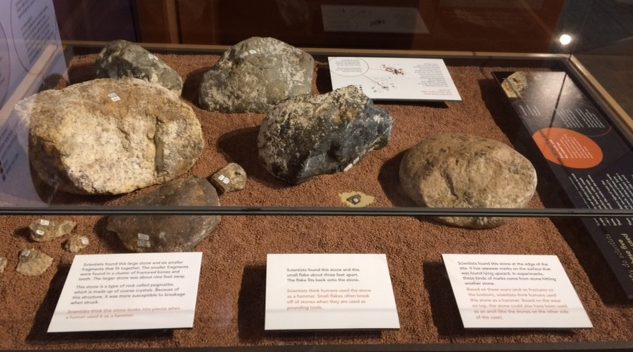
Despite the myriad questions that remain, Richard Cerutti, Thomas Demere, and their fellow team of researchers like Steven Holen, who was lead author of the research published in Nature in 2017, conclude that the site could have only been manipulated by hominin hands due to the intentional placement and transport of many of the artifacts.
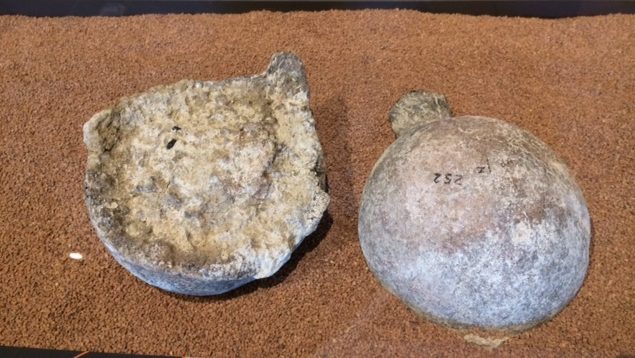
What are the implications of all this for bigfoot research? While some bigfoot researchers, myself included, have only thought scientific recognition of the bigfoot species could come about through the recovery of a bone, tooth, or body, archaeological sites in North America may offer a promising corollary. Of course, such sites must meet a certain criteria; first and foremost, an inexplicable hominin presence—be it by the extreme age of the site and/or the rather contradictory nature of the tool technology or artifacts. That said, I want to be clear that I am not directly correlating the Cerutti Mastodon site to past bigfoot activity. The site itself faces extreme scrutiny, if not outright rejection by many archaeologists, without such a scientific stigma being placed upon it. Greater scientific consensus must be reached so that the site can, in fact, be deemed archaeological and not simply dismissed as random or attributed to some other, as yet unknown force or process, as critics are now doing. After viewing the Cerutti artifacts exhibited at the San Diego Natural History Museum, I found the evidence indicating hominin activity to be profound: the hammer stones, the anvil stones, the broken mastodon bones with spiral flake fractures and impact notches, percussion damage and photos of microscopic abrasion wear patterns to the hammer stones and anvil stones, the arrangement of artifacts in two broad clusters centered around the two anvils. In fact, had I not read various articles published beforehand and had my mind not long ago entertained the possibility of a hominin better known as bigfoot turning up, for example, in a tar pit along with other Pleistocene mammals such as a saber-tooth cat or mastodon, I probably would have shared much of the same shock as Cerutti, Demere, and Holen when faced with such irrefutable evidence of hominin presence in North America in the Pleistocene epoch, circa 130,000 years ago. The most surprising aspect after witnessing the evidence firsthand—and it probably shouldn’t have been surprising for someone in my line of research—was how the Cerutti claims were dismissed out of hand by other archaeologists without so much as finding it necessary to view the artifacts and evidence in person, an opportunity readily available. Like the site itself, these absentee detractors have also been met with criticism.
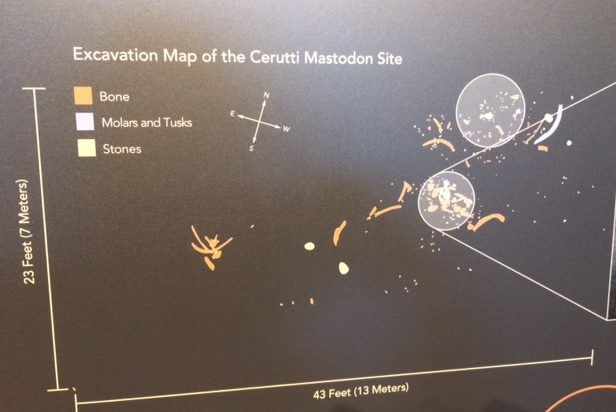
When considering potential North American archaeological sites, the bigfoot researcher or the layman with a keen interest should keep in mind the Bering land bridge has come and gone with the glacial advances and retreats over the millions of years of hominin existence and a cold tolerant hominin species could have crossed the Bering land bridge ages before our own species even came into existence. One way or another, the Cerutti site opens further possibilities and points to hominins—whoever they ultimately may be—arriving in North America far earlier than expected, and that should be one of the largest lessons here. As with any hominin, the trait of hands with opposed thumbs capable of manipulating rocks and bones, even heavy mastodon tusks,[3] surely no easy feat unless such hands come with either a commensurate power of body or a cooperative effort, just to use the established artifacts at Cerutti as an example, would be in evidence. And while there is zero indication/evidence the bigfoot species possesses flaked stone tool technology, occasional tool use is an altogether different matter as indicated by some eyewitness testimony, however sparse. Hypothetically—and I do mean hypothetically—hammers and anvils could very well be the extent of the technology needed for such a robust species to process the carcass and break open bones to extract marrow. Much of the skin, soft tissues, and meat may not need processing beyond what pure strength of hand and arms can provide, aided perhaps by a mastodon tooth smashed into a tough hide here and there. In a similar context, other archaic Pleistocene archaeological sites approximately 20,000 years old in Kansas and Nebraska have yielded mammoth bones with strong evidence of spiral fracturing, though without recovery of the rocks used to break them (Holen, 2007), generating potential archaeological parallels and a trend of manipulated artifacts that are similar to Cerutti. A welcome byproduct of archaeological sites excavated and documented like Cerutti is that hoaxing, the bane of the bigfoot researcher, can be ruled out.
In any sleuthing of extremely early North American hominin migration, it would be remiss not to mention the indigenous ethnographic literature, where possible precedent, surprisingly enough, may well exist for an archaic species occupying the continent alongside Homo sapiens. In a survey of the ethnographic literature of indigenous North American tribes, Coleman and Hall (1984) identified consistent cultural traditions which describe a primitive hominin species of immense height and strength, lacking advanced technology like fire, bows, and watercraft, with skin either hairy or akin to stone. In fact, a common theme used to describe this older species is stone, whether it is used as a physical description, in the form of stone men or stone giants, or as a reference to the limited stone technology the species possessed, whether the use of stones as weapons for example or the building of crude stone structures, like the boulders balanced on smaller rocks that still confound academics today, called Eetigaseemaute by the Inuit, though some scholars are convinced they are nothing more than geological artifacts caused by glaciation. Although there are a few anthropologists, like ethnologist and philosopher Hartley Burr Alexander, who concede there may be historical precedent in the indigenous tales, the truths now well convoluted, in the aggregate these tales are dismissed by most academics as pure folklore and myth (Coleman and Hall, 1984). Whatever the precise motif, there are ecological parallels in many of these Native American stories that suggest dispersal of the stone men—and ultimately lower population densities—amidst increased competition with Homo sapiens for land and resources. The Inuit, for example, speak of their great great-grandfathers being best acquainted with the Tornit, who are the stone men equivalents in Inuit culture (Alexander, as cited in Coleman and Hall, 1984), before the Tornit retreated far inland; other variations tell of the cognitively inferior stone men being slowly killed off by the Inuit, or the stone men battling among themselves and killing each other (Scherman, as cited in Coleman and Hall, 1984). In a similar ecological vein, the Kutchin tribe emphasizes that its version of the stone man, the Nakani, now travels singularly as opposed to the small group travel of former times (MacNeish (1954) and Osgood (1932), as cited in Coleman and Hall, 1984). Whoever the more archaic Cerutti hominins ultimately prove to be, if they had an established population on the North American continent prior to the arrival of Homo sapiens, then lower population densities—if not outright extinction—after the arrival of Homo sapiens might very well be expected if other hominin populations like the Neanderthals serve as any indication due to an increasing competition for land and scarce resources. Such an “ecological echo” may well be one of the most important historical precedents contained in these tales next to the stone men themselves.
Keeping within this theme of stone, an examination of John Green’s database shows that most observations of bigfoot using rocks or stones as tools involves usage as projectiles, often in response to human intrusion, though such projectiles are only thrown in the vicinity of the human intruder as a likely intimidation or scare tactic. There are at least twenty-four incidents of rock or stone throwing in John Green’s database, though none involve the eyewitness being hit by the projectile.[4] Reports of rock throwing also occur in the BFRO database, such as report #11897, Fresno County, CA, in which a number of 30 to 40 pound rocks were thrown into a river to scare away several human intruders. Beyond that, eyewitness observations of stone tool use are especially rare, though one well-documented case involved a bigfoot holding mussel shells in its hand while breaking them open with a rock.[5] Even this lone example is enough to raise the question of whether such behavior is potentially more ingrained, however rare, and eyewitnesses are simply not in position to observe such cases. Dr. Russell Jones (2016) documented a find in his book, Tracking the Stone Man: West Virginia’s Bigfoot, in which he and field partner Darren Pevarnik came across a large rock four feet long and three feet wide with cracked beech nuts on it, along with several smaller rocks that were used to crack the nuts open. Only hands could have manipulated the rocks in order to crack the beech nuts, yet the location was very remote and seemed to rule out any hikers or hunters. Admittedly, from these eyewitness observations at least, the incorporation of stone tools in bigfoot behavior seems rather limited, and it seems difficult to reconcile or extrapolate potential archaeological sites from such a narrow range of incidents, yet the raw ingredients are there in the form of hominin hands and the manipulation of objects. It is also worth mentioning that bigfoot has also been observed using sticks as tools in a few cases,[6] if only to further demonstrate other instances of primitive tool use in the species, though wood artifacts rarely play any role in ancient archaeological sites for the simple fact that wood decays quickly.
It is also important to acknowledge that for those bigfoot researchers who have concluded bigfoot does not have an opposed thumb, raising the possibility of archaeological sites becomes antithetical and such corollary evidence totally removed from the domain of bigfoot research. Only an opposed thumb could maintain control of the hammer stones while in the act of smashing them against bone balanced on a stone anvil underneath for example, and only a hominin hand characterized by an opposed thumb could give rise to an archaeological site such as Cerutti.
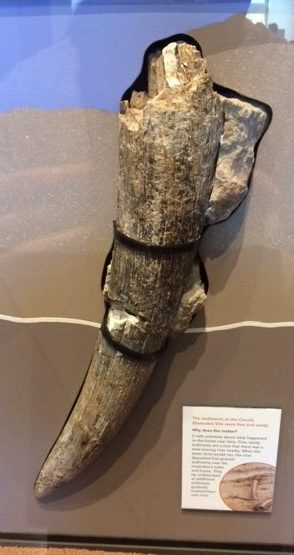
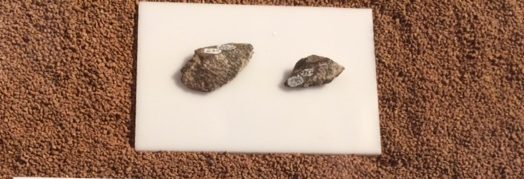
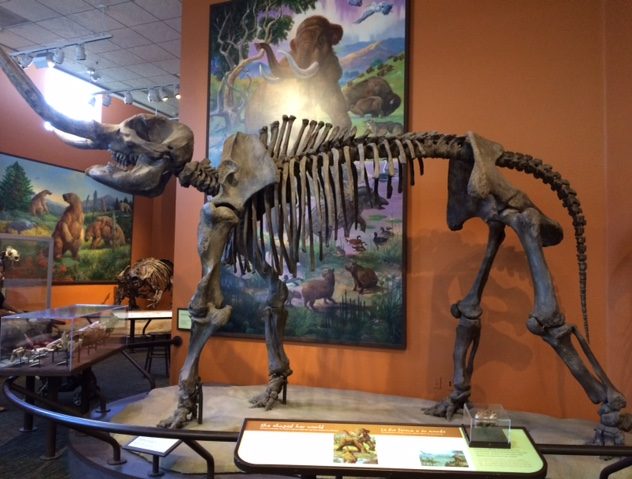
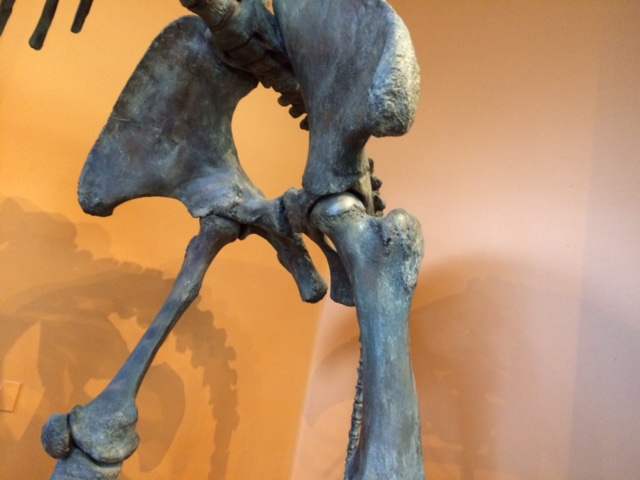
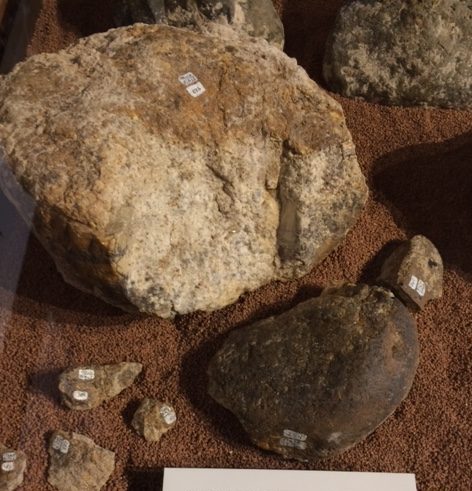
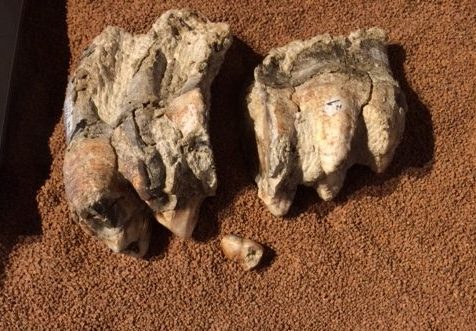
Addendum:
Further research on Inuit references to the Tornit revealed that the Inuit, who arrived in the Arctic about a thousand years ago, were preceded in this cold frontier by Paleolithic Eskimos who arrived about 4,000 years before them, and tales of meeting/interactions between the two people and cultures were preserved by Inuit oral tradition until written down by ethnologists. Robert McGhee (1997), author of Ancient People of the Arctic, concludes, “There seems to be little doubt that the Tunit of Inuit historians and the Dorset Paleo-Eskimos of archeologists were one and the same.” These Paleolithic Eskimos, also known as the Dorset culture/people in the later stage of their existence, were, at peak expansion, spread over a vast geographic area that stretched as far east as the coasts of Greenland, Arctic North America in the central territory, Newfoundland in the south, and Alaska in the west. It was only sparsely populated at far flung geographic points by small bands/families, though trade and communication remained constant, enough that the culture retained a cohesive whole. Genetic diversity was quite limited, with studies of mtDNA indicating there were very few females among the initial founding population, and perhaps only a single founding female (Pringle, 2014). These studies have also proven that the Inuit and Dorset people were genetically distinct, the Dorset people earlier Arctic migrants from Siberia, the Inuit later Arctic arrivals from Alaska (via a separate later migration from Siberia). Their distinctive cultures pointed to this conclusion a century before genetic testing removed any doubt. They can be thought of as cousins derived from the same Northeastern Asian ancestral stock.
Inuit oral tradition describes the Tunit/Tornit as non-violent, shy and retreating. Although small bands of both peoples might coexist for a short time, invariably the Tunit retreated and vanished wherever the Inuit, who had superior numbers and superior technology, like the bow and arrow, drills, kayaks, umiaks (small boats that could carry some twenty people), and dogsleds, moved rapidly into Arctic territories that comprised Dorset strongholds (McGhee, 1997). Remnants of Paleo-Eskimo tents, in the form of circular rock configurations, which held the poles, and rock foundations of Dorset long houses are still preserved in the Arctic/Subarctic, beneficiaries of the preservation of the extreme cold. The Dorset were the original architects of the land, and according to Inuit oral traditions, “the Tunit made our country habitable. They built the lines of boulder cairns that guide caribou to the river crossings where they can be ambushed by hunters, and they furnished the rivers with fish weirs,” (McGhee, 1997). While descriptions and tales such as these seem more straightforward, as do others that incorporate Tunit seal hunting techniques or describe their hot oil lamps or soapstone pots, the physical descriptions of Tunit themselves take on a near mythic quality. Curiously, despite being derived from a similar genetic lineage of Siberian peoples, with Inuit males standing 5’4” on average, for example, the Tunit are invariably described as much bigger and far more powerful, capable of feats of strength well beyond their Inuit cousins. Tunit, as muscular as polar bears, could lift boulders or drag a walrus (weight greater than one ton) by themselves (Bennett & Rowley, 2004). Caribou were run down by the Tunit, then hoisted upon their shoulders and carried away in this fashion (Bennett & Rowley, 2004). Tunit did not walk around mountains like the Inuit but went straight “up one side and down another” (Bennett & Rowley, 2004). The beds inside their houses were far too small for them so they had to sleep with their feet in the air (Bennett & Rowley, 2004).
While descriptions of the Tunit seem to suggest little more than myth-making, they do beg the question no ethnologist or archeologist would think to ask: could these oral tales represent the memories—and subsequent hybridization–of two unique “peoples” encountered by the Inuit when they migrated into expansive new lands? After all, almost all North American Indian tribes to the south have their own endemic tales or references to the Sasquatch or similar giant hairy men. The reference to the Tunit constructing beds—their small sleeping quarters still preserved in some Dorset house foundations—that were far too small for them so that they had to sleep with their feet in the air seems an especially odd contradiction, unless it is a synthesis of two distinct “peoples,” one of similar size to the Inuit, artistically advanced and technologically reliant, the other far larger, giant-like, and capable of comparatively astounding feats of speed and strength but lacking technology, except perhaps in a few hybridized mentions. It should be kept in mind that although the Arctic/Subarctic is akin to a frozen desert, a land of snow, ice, and permafrost, it is hardly barren of animals, with large populations of muskox and caribou, wood bison, bear, migrating birds, hares, fox, spawning Arctic char in rivers, and seal and walrus at the edges of the ice that may well prove a productive hunting ground for a strong, fast and capable bipedal predator existing in this area in especially low population densities. In warmer periods, tree lines moved north as much as 100 kilometres, changing animal migration patterns and expanding the range of other animals (McGhee, 1997), and perhaps creating another fortuitous opportunity for a capable predator. While this question of two “peoples” existing prior to Inuit arrival is at least worth pondering—if only to the bigfoot researcher—especially since the tales themselves almost raise it intrinsically, there seems no way of answering it satisfactorily, at least at this time.
For anyone inclined to dismiss this last point out of hand, the cautionary words of evolutionary geneticist Eske Willerslev, co-author of the genetic study of the Paleolithic Eskimos/Dorset people, about the need to reassess the importance of indigenous knowledge proves especially prescient. “Scientists are sitting around and academically discussing different theories about peopling of Americas, and you have all these different views on how many migrations, and who is related. Then when we actually undertake the most sophisticated genetic analysis we can do today, and this is state of the art, genetically — we could have just have listened to them (indigenous people) in the first place” (Allen, 2014). In this case, further interpretation of Inuit oral history of the Tunit may be warranted as well.
[1] Plus/minus 9,000 years.
[2] See de Heinzelin, et al, (1999, April 23). Environment and behavior of 2.5-million-year-old Bouri hominids. Science, 284(5414), 625-629. doi: 10.1126/science.284.5414.625
[3] Full mastodon tusks can weigh over a hundred pounds. See http://www.ohiohistorycentral.org/w/Mastodon_and_Mammoth_Fossils
[4] See John Green’s Sasquatchdatabase.com incidents 151, 348, 481, 991244, 991332, 991370, 991398, 991399, 991891, 992336, 992458, 1000138, 1000251, 1000148, 1000209, 1000422, 1000545, 1000653, 1000942, 1000951, 1000954, 1000993, 1001384, 1001431.
[5] I classify it as well-documented because the eyewitness testimony is on videotape. Unfortunately, despite investigation by a field biologist, Ranae Holland, there are no follow-up questions about the rock as tool usage that might well be expected. See Monahan, R., & Weingrab, E. (Director). (2012, March 4). Hoosier bigfoot. [Television Series Episode]. In Finding Bigfoot. Animal Planet.
[6] See Alley (2007), for a report that involves an eyewitness observation of a bigfoot using a stick for digging clams; also the use of sticks to spring bear traps. See Bindernagel (1998) for the potential use of a stick by a bigfoot to strike/kill ducks. Instances in John Green’s Sasquatchdatabase.com include using sticks as projectiles (incidents 992022, 1000455), as a weapon to beat dogs (incidents 992655, 1000677), as well as sticks being carried (incidents 992213, 992329, 992263), which could potentially point to tool use of some kind.
Bibliography
Allen, K. (2014, August 31). When science meets aboriginal oral history. The Toronto Star. Retrieved from https://www.thestar.com/news/insight/2014/08/31/when_science_meets_aboriginal_oral_history.html
Alley, J. R. (2003). Raincoast sasquatch. Surrey, Canada: Hancock House.
Bennett, J., & Rowley, S. (Eds.). (2014). Uqalurait: An oral history of Nunavut. Montreal, Canada: McGill-Queens University Press.
Bigfoot Field Researchers Association. (1995-2018). Geographic database of bigfoot/sasquatch sightings and reports. In The Bigfoot Field Researchers Organization. Retrieved from http://www.bfro.net/
Bindernagel, J. A. (1998). North America’s great ape : The sasquatch. Courtenay, Canada: Beachcomber Books.
Brodwin, E. (2017, April 26). Archaeologists have uncovered ancient bones that may rewrite American history. Business Insider. Retrieved from https://www.businessinsider.com/archaeology-first-humans-north-america- 2017- 4
Cerutti mastodon (n.d.). In theNat/ San Diego Natural History Museum. Retrieved October 16, 2018, from https://www.sdnhm.org/consulting-services/paleo- services/projects/cerutti-mastodon/
The Cerutti mastodon site (n.d.). In Online Repository of Fossils Museum of Paleontology University of Michigan. Retrieved October 16, 2018, from https://umorf.ummp.lsa.umich.edu/wp/cerutti/
Coleman, L., & Hall, M. (1984). From “Atshen” to giants in North America. In V. Markotic & G. Krantz (Eds.), The sasquatch and other unknown hominids (Vol. 1, pp. 41-53). Calgary, Canada: Western Publishers.
Curwen, T. (2017, December 22). Archaeology as blood sport: How an ancient mastodon ignited debate over humans’ arrival in North America. Los Angeles Times. Retrieved from http://www.latimes.com/local/california/la-me-cerutti- mastodon-20171222-htmlstory.html
de Heinzelin, J., Clark, J. D., White, T., Hart, W., Renne, R., WoldeGabriel, G., & Beyene, Y. (1999, April 23). Environment and behavior of 2.5-million-year-old Bouri hominids. Science, 284(5414), 625-629. doi: 10.1126/science.284.5414.625
Green, J. (n.d.). Sasquatch research engine. In Sasquatch database. Retrieved from http://www.sasquatchdatabase.com
Hoag, H. (2017, April 26). Broken bones could rewrite story of the first Americans. In Sapiens: Anthropology/Everything Human. Retrieved from https://www.sapiens.org/archaeology/mastodon-bones-human-migration/
Holen, S. R., Demere, T. A., Fisher, D. C., Fullager, R., Paces, J. B., Jefferson, G. T., Beeton, J. M., Cerutti, R. A., Rountry, A. N., Vescera L., & Holen, K. A. (2017, April 27). A 130,000-year-old archaeological site in southern California, USA. Nature, 544, 479-483. https://doi.org/10.1038/nature22065
Holen, S. R. (2007). The age and taphonomy of mammoths at Lovewell Reservoir, Jewell County, Kansas, USA. Quaternary International, 169, 51-63. doi: 10.1016/j.quaint.2006.08.006
Jones, R. L. (2016). Tracking the stone man: West Virginia’s bigfoot. N.p.: Willamette City Press, LLC.
Khan, A. (2017, April 26). 130,000-year-old mastodon bones could rewrite story of how humans first appeared in the Americas. Los Angeles Times. Retrieved from http://www.latimes.com/science/sciencenow/la-sci-sn-americas-first-humans- 20170426-story.html
Mastodon and mammoth fossils (n.d.). In Ohio History Central. Retrieved October 10, 2018, from http://www.ohiohistorycentral.org/w/Mastodon_and_Mammoth_Fossils
McGhee, R. (1997). Ancient people of the Arctic. Vancouver, Canada: UBC Press.
Mitchell, E. H. (2016, October 17). Stones of mystery. In Canada’s History. Retrieved October 1, 2018, from https://www.canadashistory.ca/explore/first- nations,-inuit-metis/stones-of-mystery
Monahan, R., & Weingrab, E. (Director). (2012, March 4). Hoosier bigfoot. [Television Series Episode]. In Finding Bigfoot. Animal Planet.
Osborne, H. (2017, April 26). What was our first human ancestor in America? Butchered bones point to mystery hominin in California 130,000 years ago. Newsweek. Retrieved from https://www.newsweek.com/mystery-human- species-americas-mastadon-bones-590344
Pringle, H. (2014, August 28). Ancient DNA Sheds New Light on Arctic’s Earliest People. National Geographic. Retrieved from https://www.nationalgeographic.com/news/2014/8/140828-arctic-migration-genome-genetics-dna-eskimos-inuit-dorset/
Team discovers ancient migration wave from Siberia to the Arctic. (2014, August 28). In University of Kansas. Department of Anthropology. Retrieved from https://anthropology.ku.edu/cherry-picked-team-discovers-ancient-migration-wave-siberia-arctic
University of Copenhagen. (2014, August 28). Prehistoric migrations: DNA study unravels the settlement history of the New World Arctic. ScienceDaily. Retrieved from www.sciencedaily.com/releases/2014/08/140828142748.htm
Yong, E. (2017, April 27). A new study says humans were in America 130,000 years ago. The Atlantic. Retrieved from https://www.theatlantic.com/science/archive/2017/04/new-study-puts-humans- in- america-100000-years-earlier-than-expected/524301/
Copyright 2018 T. A. Wilson. All rights reserved.